Site menu:
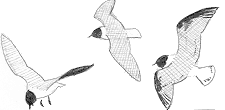
May 2011 Newsletter
Spring Migrants - Part 2.
April Bird News.
Forthcoming Events.
Latest Newsletter.
Spring Migrants - Part 2
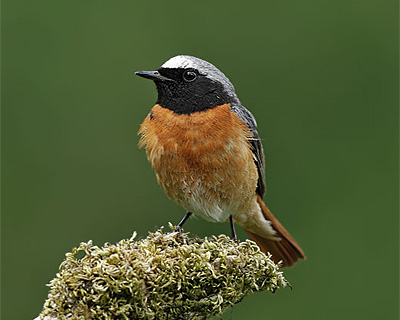
This is the second of two articles about spring migrants, the first featured Ring Ouzels and Yellow Wagtails - published in last month's newsletter.
Common Redstart
The majority of Redstarts winter just south of the Sahara although ringing recoveries suggest a substantial minority winter in north Africa and into southern Europe. Birds breeding in the UK migrate north through the Iberian peninsula and France. The first ones arrive around the Dee Estuary in early April but there is a definite peak in the second half of the month with much smaller numbers into May, as can be seen on the graph. According to the BTO Migration Atlas there is no evidence that Scandinavian breeding birds pass through here.
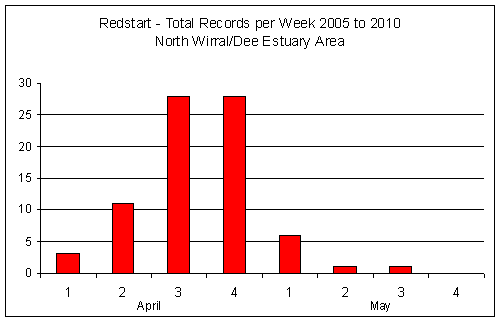
More birds are recorded on Hilbre and around Leasowe Lighthouse than anywhere else, but most years they also turn up at Gronant, Point of Ayr, Red Rocks and Gilroy Nature Park. Usually just singles are seen but up to three at a time have been noted.
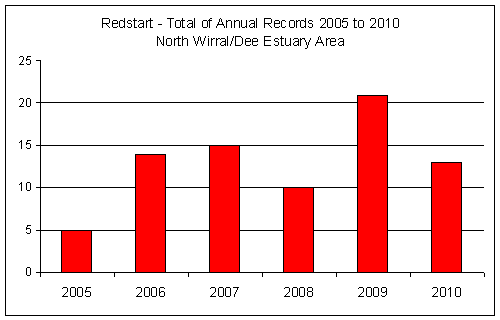
Redstarts breed in both Cheshire and Clwyd, in the eastern hills of the former and mostly in the western half of the latter. They seem to be decreasing locally as a breeding bird although nationally numbers are fairly stable; it is on the Amber List as it is decreasing in some European countries. They probably do occasionally breed closer to the Dee Estuary, a male was seen feeding a young juvenile near Oldfield Farm, Heswall, in early July 1995.
Wood Warbler
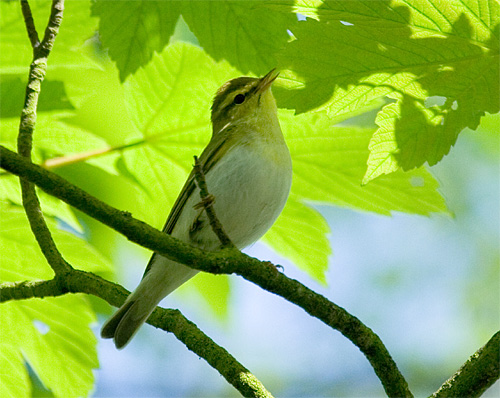
Of the four species featured in these 'Spring Migrant' articles the Wood Warbler winters the furthest south. Ringing recoveries show that British breeding birds migrate south-eastwards along the Italian peninsula to reach their wintering grounds in equatorial Africa. They appear to fly non-stop from southern Europe over the Sahara to central Africa. During Spring migration they stop off in North Africa before flying back to the UK further west than in the autumn - in a clockwise loop migration pattern.
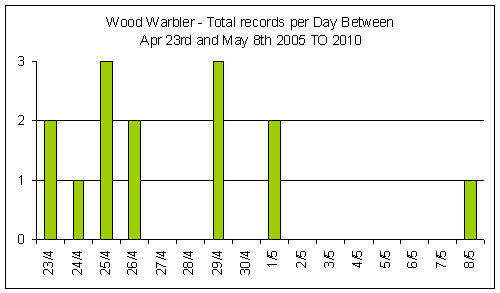
During the past six years birds have only been recorded between April 23rd and May 8th around the Dee Estuary. Although they have been seen at Point of Ayr and Leasowe Lighthouse the more usual sites are mature woodland, preferably on a slope. Birds are recorded at Stapledon Wood, Caldy, most years but are probably also regular on the Welsh side of the estuary at Wepre Park, Greenfield Valley and Garth Wood although I suspect they are under-recorded at these three sites. They rarely stay for more than a day or two, but I was lucky enough to have one stay a week near my house close to Stapledon wood in 2001 - in full song! It is the distinctive song that normally gives it's presence away; they can be difficult to spot in the leaves, but when you do see them the lovely yellow head and breast makes identification straightforward.
Wood Warblers used to breed in Stapledon Wood, three pairs were recorded in 1979 according to the first Cheshire and Wirral Atlas, but now they are restricted mostly to the east of the county. Recent North-east Wales Bird Reports suggest that birds do breed in Clwyd but are scarce. Regrettably they are also declining nationally, for reasons which are not clear.
Sources of information for this article:
1. The Migration Atlas, BTO, 2002.
2. David Norman, Birds in Cheshire and Wirral (Atlas), CAWOS, 2008.
3. Cramp & Simmons, Birds of the Western Palearctic, DVD edition BWPi, 2006.
4. Cheshire and Wirral Bird Reports, 2005 to 2009, CAWOS.
5. North-east Wales Bird Reports, 2005 to 2009, Clwyd Bird Recording Group.
6. Records on this website (
www.deeestuary.co.uk), with many thanks to the numerous birders who
sent in Common Redstart and Wood Warbler sightings.
7. J.P. Guest et al., The Breeding Bird Atlas of Cheshire and Wirral,
1992.
Richard Smith
April Bird News
Spring migration was certainly in full swing, but for some birds it was still winter! The first day of the month started with the three Waxwings still at Deeside when 16 turned up in Heswall. Two days later 19 were showing well in Irby and stayed for four days. 49 Waxwings were obviously in a hurry to go north on the 16th at West Kirby, but 10 at Wallasey stayed a couple of days a week later. 20 Whooper Swans were still on Shotwick Fields on the 5th. 30 Brambling were at Inner Marsh Farm on the 15th and there were still 82 Brent Geese around Hilbre early in the month.
The spring migration started in earnest on the 2nd, with over 60 Wheatears and a male Redstart at Leasowe, a total of four Ring Ouzels around north Wirral and 14 White Wagtails at Thurstaston. There were many excellent days but two stand out. The 9th when there was a massive influx of White Wagtails on to the shore at West Kirby and Hoylake. At least 400 were counted and I suspect the total was probably over 500 but as they were to-ing and fro-ing during the day it was difficult to be sure that there was no double counting. The other great day was Good Friday (22nd), particularly in the Leasowe Lighthouse area where there were a total of at least 80 Wheatear, 12 Yellow Wagtail, 10 Grasshopper Warbler, 4 Lesser Whitethroat, 1 male Redstart, 1 male Ring Ouzel and 2 Whinchat, among others!
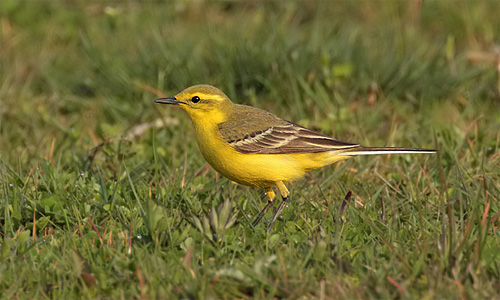
| Species | 2011 | Location (2011) | 2010 | 2009 |
|---|---|---|---|---|
| White Wagtail | 11th March | West Kirby | 12th March | 4th March |
| Sand Martin | 12th March | Hilbre | 18th March | 15th March |
| Wheatear | 13th March | West Kirby, Meols, Inner Marsh Farm and Red Rocks. | 10th March | 14th March |
| Swallow | 20th March | Hilbre | 18th March | 16th March |
| Willow Warbler | 16th March | Leasowe Lighthouse | 19th March | 31st March |
| House Martin | 25th March | Inner Marsh Farm and Thurstaston | 30th March | 30th March |
| Whitethroat | 8th April | Thurstaston | 7th April | 11th April |
| Swift | 17th April | Burton | 19th April | 8th April |
| Cuckoo | 20th April | Burton | 10th May | 26th April |
It was a great spring for Grasshopper Warblers, as well as the 10 at Leasowe mentioned above there were also 10 at Red Rocks on the 20th, with good numbers on several other days at both locations, many showing very well at remarkably close quarters. Have a look at http://stevenround-birdphotography.blogspot.com/ (27th April) for some great photos. 300 Sand Martins over Inner Marsh Farm on the 7th was a record high for that site.

Spring migration over the sea was also very good, following on from the large numbers of Little Gulls at the end of March 200 flew past Hilbre on the 1st with 68 on the 2nd. It was good to see the terns return. There were at least 80 Common Terns off north Wirral on the 27th, I understand there were also plenty within the estuary itself and we are hoping they have a successful breeding season at Shotton this year after two years of complete failures. Little Terns returned to Gronant where there were at least 12 present on the 23rd. Sandwich Terns were also much in evidence, these do not breed here but passage birds reached a maximum of 130 off Leasowe on the 18th. There were plenty of Gannets passing by (max 120) and a flock of about 1,000 Common Scoter was seen from Hilbre towards the end of the month. Single Arctic and Great Skuas flew by, three Manx Shearwaters were off Gronant and there were still up to 100 Great Crested Grebes off Leasowe.
A total of six Ospreys flew over during the month. Rarer birds included a Hooded Crow on Hilbre (1st), a Serin at Burton (9th) and a Black Redstart at Leasowe (19th). The first Garganeys arrived on the 19th with three at Inner Marsh Farm, at least two were then spotted several times to the month-end. I was lucky enough to find a pair at Gilroy Nature Park on the 21st.
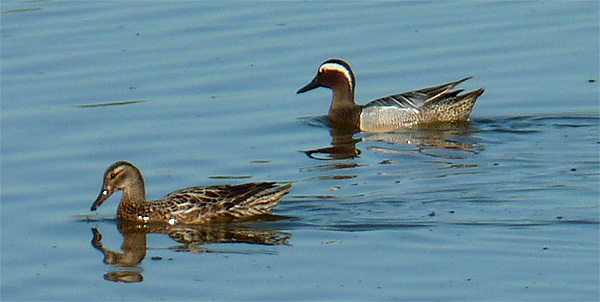
Richard Smith.
What to expect in May
We often get some good rarities in May due to
'migration overshoot'. Last year we had both a Bluethroat and a Nightingale
early in the month, and a Black Kite. Spoonbills sometimes turn up, presumably
these are wandering non-breeding birds.
Spring migration will still be underway in the first week or so and can be
particularly good for Whimbrels and Whinchats. A few Common and Wood
Sandpipers will be passing through, and Spotted Redshanks will be looking
fabulous in their summer plumage. We may well get several hundred
Black-tailed Godwits at Inner Marsh Farm, these will be mostly non-breeding
birds as the breeding season will already be well underway in Iceland. Look
out also for flocks of the more common waders such as Dunlin, Ringed Plover
and Sanderling; birds passing through here in May will most likely be
travelling thousands of miles in transit from their wintering to their breeding
grounds.
A fresh westerly will result in good numbers of sea birds offshore and
hopefully will include Arctic Skuas and Manx Shearwaters, and maybe some of
the scarcer skuas. Marsh Harriers, and perhaps a late Osprey, should be
seen, and hopefully more Garganeys and Hobbies.
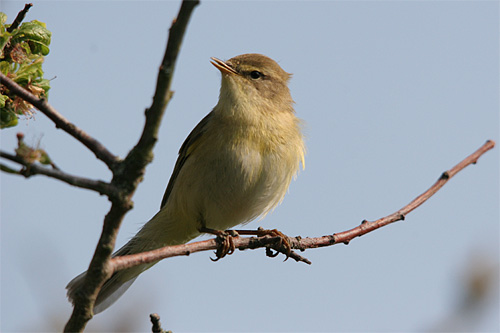
Forthcoming Events
May Highest Spring Tides (Liverpool)
Also see
Tides page.
17th May, 11.34hrs (BST), 9.5m.
18th May, 12.22hrs (BST), 9.5m.
Forthcoming Events
Organised by the
Wirral Ranger Service ,
Flintshire Countryside Service and/or the RSPB:
All these events and walks have bird interest, even those not advertised
specifically for birdwatching. No need to book for these events unless
specified - please check below.
Also see 2011 Events Diary.
Sunday 1st May, Bluebells, Birdsong and Burton Mere (RSPB Event).
See poster below for details.
Sunday 1st May, 4:30am - 6:30am, Dawn Chorus at
Royden Park and Thurstaston Common.
Up with the Lark and listen to the delights of nature’s own dawn chorus.
Note - This is a very early start!
Sorry no dogs.
Booking essential (numbers limited to a maximum of 18).
Meet at Royden Park by the Coach House.
Telephone: 0151 648 4371 to book.
Saturday 7th May, 6am start, The Big Breakfast - Wirral Country Park (Thurstaston).
Join the Rangers for a special bird watching event with a treat at the
end! Search the hedgerows and grasslands of Wirral Country Park and the
Wirral Way for spring migrants and breeding warblers before heading to
GJ’s café for a Full English breakfast to round off the mornings birding.
Dee-licious!
Booking essential (15 places max). Cost: £5 charge to cover breakfast.
To book and for more info ring 0151 648 4371.
Saturday 7th May, 7am to 9am, Dawn Chorus at Claremont Farm (Bebington).
A guided walk around Claremont under the guidance of our friendly RSPB
staff from Inner Marsh Farm. A chance to see and hear the wildlife that
thrives on this Higher Level Stewardship Farm.
We will be keeping a close eye out for grey partridge, yellowhammer, tree
sparrow and also our resident kestrel, buzzard, great spotted woodpecker
and green woodpecker.....not to mention the hares! Booking essential.
For details of how to book, the location etc. please Click
here, or ring 0151 334 1906.
Tuesday 10th May, 10am to 4pm, Garden Wildlife Photography - RSPB Event.
Using your camera to record the wonders of the natural world in your
garden.
See details below - Click Here.
Saturday 14th May, 7am start, “Up with the Lark” at Ness Gardens.
An early morning walk around the gardens when the birds should be in full
song for the Dawn Chorus, followed by a full English breakfast. Booking
through Ness gardens is essential – please ring: 0151 353 0123.
Sunday 15th May, 10:30am - 12:30pm, What's that Bird? -
Royden Park.
Join the Ranger on the walk to discover the variety of birds that nest and
migrate to Royden Park.
We will finish with look at the static birds of prey display in the Coach
House.
Meet at the Coach House in Royden Park. Sorry no dogs.
Please wear suitable footwear.
For further enquiries telephone: 0151 677 7594.
Saturday 28th May, 11am-1pm,
The RSPB have organised a free guided walk around Rowlands Red Poll Beef
Farm at Mickle Trafford. (Post code CH2 4EB).
The farm is in the Higher Level Stewardship Scheme and has taken up
several options for that are improving the farm for wildlife. Find out all
about these and see some wildlife along the way.
Birds we hope to see include yellowhammer, tree sparrow, lapwing, swallow
and sedge warbler.
And whilst you are there why not peruse the local produce stalls as a
produce fair runs from 10am-2pm
The farm grazes Red Poll cattle along the lush Gowy meadows.
For more details ring the RSPB on 0151 336 7681.
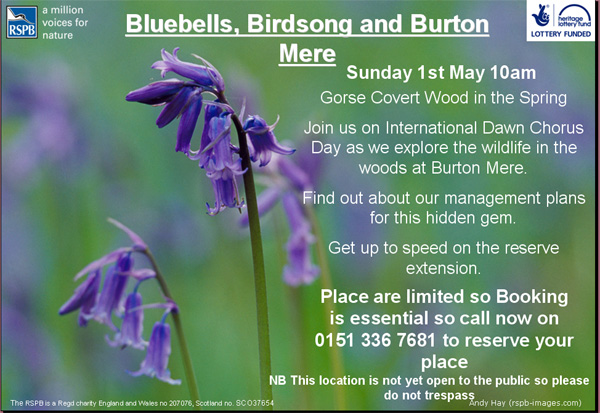

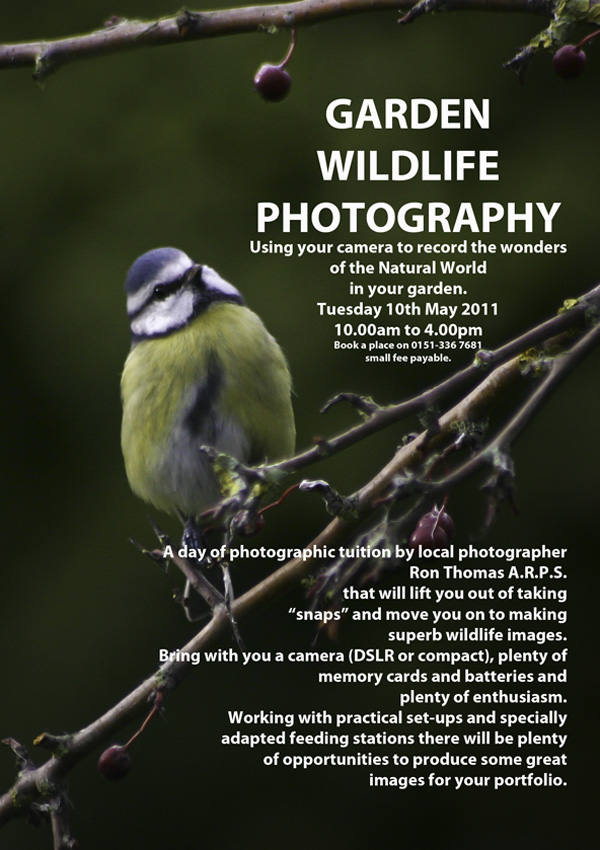
|
 |
The blank (UK) Birding Webring is a collection of quality birding web sites that are based in the United Kingdom. Visit the webring homepage for more information, or A complete list of all the sites in the webring is available by clicking here. previous site in ring : random site in ring : next site in ring |